Type 97 Te Ke Tankette Restoration
Restoration by Stan Gajda
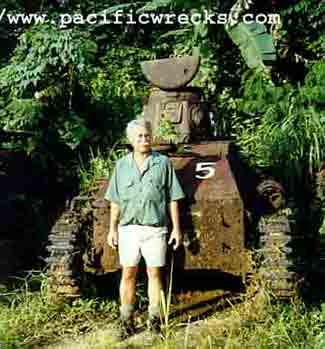
Type 95 Tank
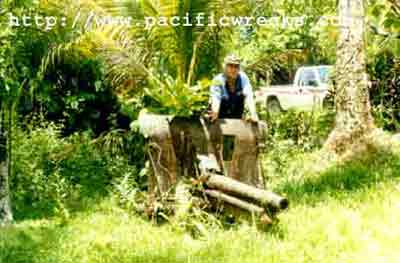
Japanese 75mm Gun
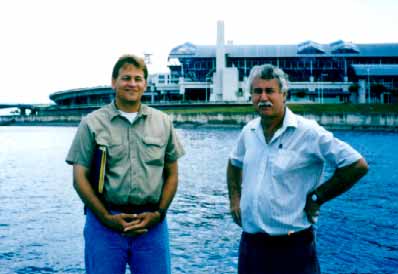
Larry Adams & Stan Gajda

Type 97 before restoration

Type 97 at workshop

Items found inside

After 14 months restoration

Nissan Engine installed

Stan Gajda with Tankette
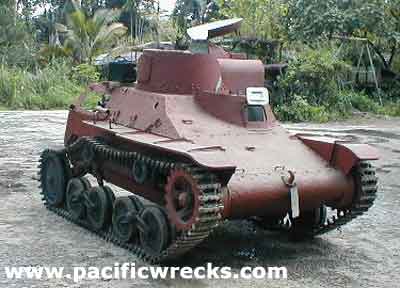
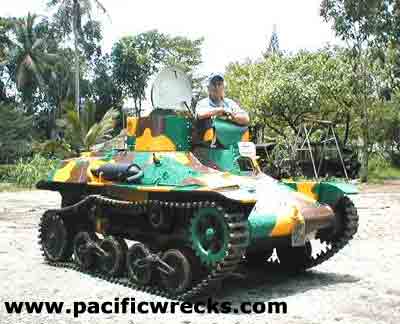
Before & After Painting
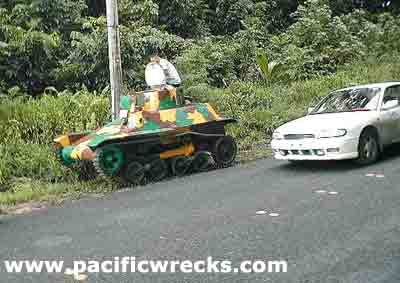
First Road Trip
|
How did this restoration come about?
I work for Larry Adams who is the son of Jack
Adams and Yvette Eischart. My job with ABC is maintenance manager / mechanic.
I came here from Nauru and Larry employed me so that I could fix the tanks for him.
At the turn of 20th century the Eischarts
acquired a large amount of land around Kolonia from the German administration. During World War II, the Eischarts
Property on Ponape was
a Japanese tank park. In the hillside, a number of revetments were cut and into these were parked
the
Japanese
tanks.
Today this land has been split up somewhat and much reduced but
the Adams family still retain quite a bit of land. The property
is in Kolonia at the south end of town on the way to Nett. Larry's
mother has two sisters and between the three sisters all Adams land
is titled to them.
Larry Adams has this dream of a family war museum
one day. Most of the time it
will be displayed in a shed together the Type 95 restoration (when that
happens). There are no plans to sell any tank parts or export anything.
The Adams want it all to stay on Ponape.
When did the restoration process start?
When I started work for ABC in November 1998
I began clearing away around the more important junk and salvaged
the Type 97 Te Ke Tankette that I restored. All the Type 95 tanks were drained
of water and cleaned out. The contents were carefully cleaned
and stored. I made an assessment of all the tanks which I put on
an excell sheet.
Very little ammo was found. One 37mm trainer
round was found under the drivers floor. Most main guns have breech
blocks. Gun spares found in the tanks will complete the guns for
the parts taken out at the wars end. When I was cleaning out the
tanks I did find some ammo in one of them, 7.7mm
rimless stuff. And one fired case which has a distinctive
firing pin indentation from the Type 7 tank gun. All are in
nice condition after spending more than 50 years submerged
in oily water. Each tank was full of water and all sorts of
green muck which had to be transferred to a bucket by trowel
and then heaved over the side through the very small turret
hatch after they were drained. It took a while over a number
of weekends and it was a dirty filthy business.
The tanks were then picked up and moved to another
area we prepared to get them away from the work area. Four Type 95s
were put under cover which were deemed the best ones to be used
in the complete restoration to original of one Type 95 tank. One other
real crappy Type 97 is also in a shed. Two tanks had totally complete
interiors with all gauges etc. Kids got in recently and smashed
all the gauges in one of them so I welded the other closed so nobody
can get in until it is needed.
Every tank still had full machine gun magazine racks full
of 7.7mm clips. Many were totally rooted but many also came out
like new with all original blueing and working springs etc. Most
tanks were still full of tools and spare parts and wood boxes and
main gun spares etc. All this has been saved and is stored. There is enough tank stuff on the Adams property
to make one complete running tank equipped with all original gear
and with a working main gun. We even have the armoured shields that
go around the hull machine guns.
Engine Installed January 30, 2002
The tankette originally had a four-cylinder air-cooled Mitsubishi engine with enclosed valve gear and oil pressure lubricated rockers like modern engines. It had a single starter motor attached to the alloy bell-housing. The motor was completely seized due to water in the cylinders and is stored for the time, when one day, when it can be seriously overhauled.
To get it mobile, I fitted a Nissan Atlas light truck and although smaller than the original, develops the same horsepower It fits directly onto the original engine bearers. I did not cut or weld anything on the tank. I also used the Nissan gearbox and clutch and made a new propeller shaft to connect the original tank transmission. The Nissan box is a 5-speed, the tank box is a 4-speed so I have a choice of 20 forward gears and two reverse gears. This is a good thing because 1st-1st gives a very slow creeping speed which is ideal for maneuvering around.
To cool the Nissan engine I fitted the Nissan radiator horizontally under the air intake on the rear engine deck and use an electric fan to force the air through. It all works just fine and I have a key start at the driver's position and an amp and water temp gage. The colors it is painted in are duplicates taken of remaining paint in hidden areas on the two tankettes and the other tanks. The camo pattern is modeled on the pattern seen on photos of various tanks in the AWM photo archives. So it looks as it did in 1945 and the old locals reckon it even sounds the same, so I was happy with that.
To make the drive shaft I used the front universal joint from the other tankette wreck and we cut the Nissan shaft and spliced the tankette joint to it and welded it. This shaft, as in the original, spins like crazy right next to the driver's right leg and if the joint lets go, the shaft would beat the driver to death. There was no safety hoop in the original installation but I made a hoop out of 1-1/2" x 3/8" steel bar and bolted it to two convenient holes near the drivers position. Now I drive it with a small safety margin built-in.
When I originally got the tankette going I had the rear armor plated off because I had just fitted the engine. The following weekend I put it all back together and took it for another blast down the road. I had also replaced the clutch plate because the original was not much good. I had used the gray PVC pipe for the water connections, thinking this pipe was the proper hot-water approved tubing. The engine was installed with the clutch and gearbox facing forward and this was just behind the driver's position/seat.
I took the tankette for a run down the road and it was getting hot, the cooling system was later refined and improved. As I backed off the throttle coming down the hill, the water surge through the engine caused one of the pipes to pop off the hose connection. This was due to the PVC becoming soft with the hot water. The pipe that came off was the one coming out of the radiator and the end was facing forward. I got drenched with near-boiling water until the engine pumped the cooling system dry. I could not get out because a friend was sitting on the turret hatch for the ride. I eventually squeezed out through the small hatch above the driver. I was already burned across my entire back. I ended up in hospital and the pain was pretty gruesome. I was on my stomach for three weeks before I could get around again. I reckon that damned tankette nearly killed me!
When I got better I replaced all the plumbing with steel galvanized pipe and put double hose clips on every connection. I also installed a sheet steel bulkhead between the engine and the driving compartment. There is not much room in there but I was sure as hell never allow that to happen again. Not to me nor anybody else. And it remains like this today.
It Runs! February 25, 2002
Much excitement here yesterday, I finally got the
tankette running and spent some time driving around all over the
workshop yard. The project took 18 months to complete, cost about
$5,000 and took 2,000 hours of work, and components from other tanks
on Tarawa, Kiribati and Nauru.
Camouflage Paint Scheme March 2002
Japanese Army tanks were all painted that three-colour
splinter scheme. I used Australian War Memorial photos to set up
the pattern on this one before painting. The other Type 97 has numerous
patches of original three colours paint around it and it is from
these that I arrived at the colours I used to paint this T97 so
as far as I can tell it is looking much the same as it was in 1945.
Road Trip April 2002
I was responsible for the biggest stir Kolonia has seen for some
time. I drove the completed Type 97 tankette down the road to Ace Hardware
and parked it outside for all to see over the whole morning. Minor traffic
jams occurred as I drove down the hill. Many people stopped and came
to have a look and talk and wonder at this largely unknown resurrection.
Media Attention
The tank caught many by surprise and eventually the local TV channel, BNN
came around to did an interview and they filmed the Type 97 and then also
the trip back to the workshop when I left Ace at midday. This video
was shown on cable tv last night and runs for about half an hour. They
titled it 'WWII Japanese Tank Comes Alive!'
The interior is not properly completed. The mg ammo racks have not been restored and when they are one day, by somebody, they are installed right behind the driver's seat on the left side. The battery is located in the same place as the originals, on the right of the driver, there were two but I made a carrier for just one. Also there were fuel and oil filters and all the plumbing for the oil cooler and etc around the engine and to the right of the driver. The fuel tank is just to the right of the driver and forward slightly. The filler hatch is at the top of the sloping front armor. We had to make a new fuel tank but used all the original brass filler spout and cap and all the fittings and valves and pipework." |
|